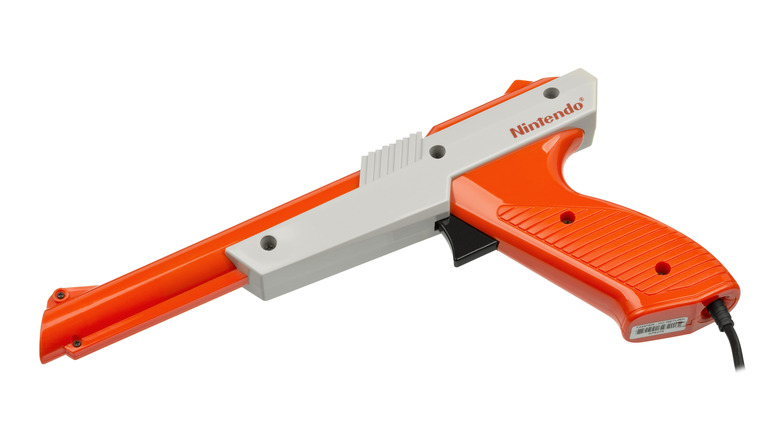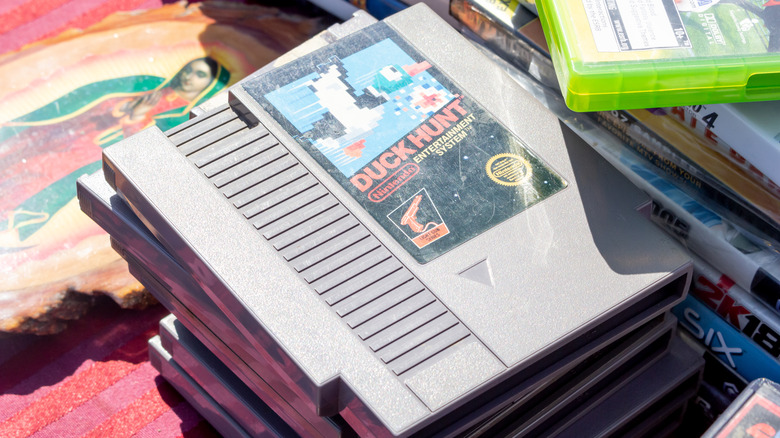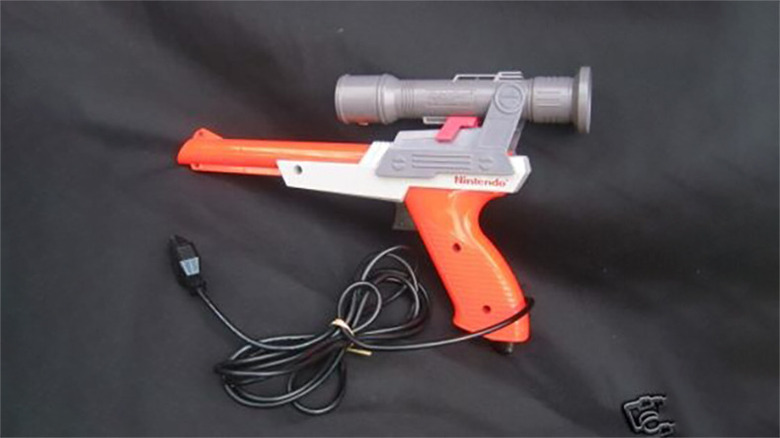This Is How The Duck Hunt Gun Actually Worked
The simplicity of hunting down ducks by pointing a toy gun at the TV and pulling the trigger thoughtlessly made "Duck Hunt" one of the most-enjoyed Nintendo Entertainment System (NES) games. Its chuckling dog quickly became the most frustrating thing in video game history. Whether you were one of the multiple siblings who constantly squabbled to shoot the ducks down or a single child who spent several hours mastering your shooting skills, "Duck Hunt" was a great stress-buster.
Although a kid's imaginative brain could make the fake gun feel real, its only feedback was its iconic "k-chang" noise. No lights emanated from its barrel or anything like that, making its workings mysterious. This generated much curiosity about how it accurately detected the pointer's location, even without virtual crosshairs available in first-person shooter games today. Even more interesting is that the gun — marketed as the Nintendo Zapper — worked with any TV or screen, making it (almost) universally compatible during that era.
The origin of the light gun
"Duck Hunt" first arrived with the Zapper gun in 1984 in Japan and reached American homes by 1985. However, the legacy behind the gun used with games like "Duck Hunt" can be traced back to the 1930s, when the first "light guns" were created. These light guns used phototubes or vacuum tubes capable of detecting light.
The earliest known light gun game, Ray-O-Lite, was introduced in 1936 by Seeburg, a company that specialized in producing components and systems for jukeboxes. In this game, players used a light-emitting gun to shoot at small, moving targets with photoelectric sensors. Whenever the beam of light from the gun struck a sensor on the target, the game could detect it. A similar principle set the stage for the Zapper gun used to play "Duck Hunt."
By the 1970s, video games with light guns became slightly more popular, thanks to the Magnavox Odyssey video game system. However, they failed to become a hit because the gaming system was only compatible with Magnavox TVs.
What made NES Zapper so popular
Other than limited compatibility, the Magnavox gaming system itself was primitive and did not have actual moving objects. Instead, it required you to stick translucent posters on the TV while blobs of light flashed at different places on the screen.
Its wider compatibility made the NES Zapper gun popular among children and adults worldwide. The Zapper also led to countless alternatives and knock-offs using similar technology. While a pistol inspired the original Zapper, other light guns came in different designs, like one with a double barrel and others with mounted eye sights and scopes, such as the Super Nintendo's Super Scope 6.
The Zapper was initially released with a Wild West-inspired game, "Wild Gunman," and supported many other games, including "Hogan's Alley" and "Gumshoe." "Duck Hunt" became the poster boy for the product due to its cartoonish graphics and mild violence, as well as being included on a cartridge with "Super Mario Bros." that came with the console in many regions.
Components of the Duck Hunt Zapper gun
Nintendo reversed the principle of light guns with the Zapper by placing a photo-sensitive diode (called a photodiode) inside the gun and having the detectable light appear on-screen. This was the opposite of previous light guns, which fired a beam of light at photoelectric sensors on the targets. This made the Zapper compatible with almost any display of the time.
The photodiode was a simple semiconductor that converted light into an electrical signal. The electrical signal could vary with the intensity of the light, and the photodiode is therefore used to detect the amount of visible light.
In the context of "Duck Hunt," the Zapper photodiode detects changes in light intensity when players pull the trigger. For a brief moment during the trigger pull, the ducks would turn into white blocks on a black screen, and the photodiode would register a hit if it could "see" one of the white boxes. This is why it worked better if you held it directly against the TV — the white box was easier for the photodiode to detect when held up close.
The NES Zapper worked with any TV or screen
When firing at multiple targets, the game would display white blocks around each potential target individually. By detecting the sequential changes in light, the console could determine which targets you had hit.
Since this process only took a few milliseconds, you would likely not notice the blackout or the targets flashing while playing the game unless you knew to look for them. Flashing images on the NES were also not uncommon due to its graphical capabilities and were overlooked by most players.
Nintendo's implementation helped patch one major issue with older light guns where players would point the gun at any bright light source, cheating the system into believing the targets were being shot. The game needed the contrast of a white box on a black background for the sensor to detect it correctly, and a standard light wouldn't contain a dark background.
As a homage to the Zapper's iconic legacy, Nintendo has included the Zapper as a weapon in the Splatoon game series and the "Duck Hunt" dog, along with a friendly duck, as a character in the "Super Smash Bros." series.




